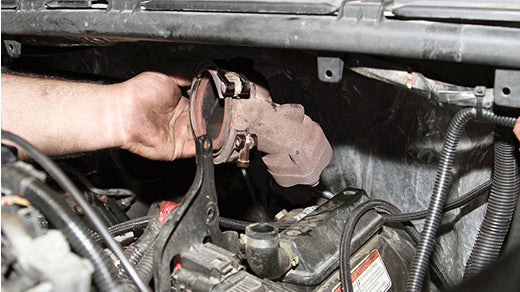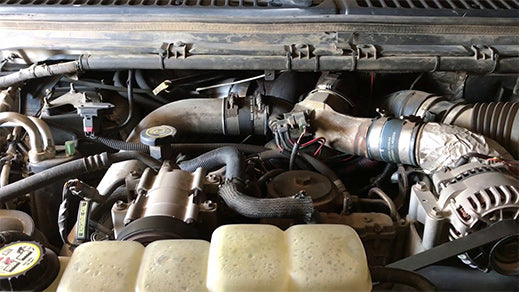7.3 Up pipes
- Author: SPELAB Mechanical Engineer (focusing on car modification for 10 years)
We all know that an engine produces power by burning air fuel mixture. These burnt gases are hot enough to turn over the turbine which helps engine in breathing heavily and thus producing more power. In vehicles powered by a 7.3L diesel engine, the up pipe is a crucial component that helps to improve the overall performance of an engine. The 7.3L diesel engine, also known as Powerstroke engine is a powerful and reliable engine that is commonly used in Ford trucks. The engine is known for its durability and longevity, but like all engines, it can experience problems and require maintenance.
What is 7.3 Up pipe?
The 7.3 up pipe is a component of the exhaust system in Ford trucks that are equipped with the 7.3L Power stroke diesel engine. This pipe is a component in the exhaust system that connects the exhaust manifold to the turbocharger. It is responsible for directing exhaust gases from the engine to the turbocharger, where they are used to spin the turbine and generate boost. The up pipe is a critical component in the exhaust system as it helps to improve the overall performance of the engine.
Like other types of up pipes, the 7.3 up pipe is designed to withstand the high temperatures and pressures that are created within the exhaust system. The pipe is typically made of stainless steel or aluminized steel, which are both materials that can resist rust and corrosion. Additionally, the pipe is usually coated with a heat-resistant material that helps to prevent warping or damage from high temperatures.
Significance of Up pipes
To understand the significance of up pipes, focus on the respiratory system of a human being. When a human is sitting idle, he is breathing normally but when he is working or exaggerating he starts to breath heavily. Same, is the case with the vehicle. When a vehicle is not pushed to its limit it breathes normally but when we push it to its limit we need to ensure proper amount of oxygen for the engine. Because, this up pipe can limit the amount of oxygen which is going inside the engine and as oxygen is limited the performance is reduced because fuel burning suffers. It is similar to a human, that, if at the time of exaggeration, a human cannot get the required amount of oxygen he would fail and same is the case with the vehicle. Therefore, we need to be extremely careful about the intake and exhaust strokes of our vehicle.
Not only in terms of power and performance does the vehicle suffers, but a damaged up pipe is also the source of environmental emissions which damages environment and have huge fines and legal penalties if caught.
Types of Up pipes
There are several types of up-pipes, each designed for specific applications and vehicles. The main types include:
- Stock Replacement Up-Pipes: These are designed to be a direct replacement for the factory up-pipes and are typically made of the same materials and construction as the original pipes. They are a good option for those looking to replace worn or damaged factory up-pipes without making any significant performance upgrades.
- High-Flow Up-Pipes: These are designed to improve exhaust flow and increase horsepower and torque. They are typically made of high-quality materials such as stainless steel or aluminized steel and feature mandrel-bent tubing for maximum flow. They are a good option for those looking to make performance upgrades to their vehicle.
- Bellowed Up-Pipes: These are designed with a bellow, or a flexible section, built into the pipe. This design allows for movement and expansion of the exhaust system, which can help reduce the risk of cracking and leaks. They are commonly used in high-performance and off-road applications.
- Turbocharger Up-Pipes: These are designed to connect the exhaust manifold to the turbocharger and are typically made of high-quality materials such as stainless steel. They are designed to withstand the high temperatures and pressures associated with turbocharged engines.
-
Up-pipes with EGR: These are designed to include EGR (Exhaust Gas Recirculation) systems. They are typically used in diesel engines, to recirculate a portion of the exhaust gas back into the combustion chamber to reduce emissions.

It's important to note that when choosing the up-pipes, it's crucial to select the one that fits your specific make, model, and year of your vehicle, as well as your desired application and performance goals.
Common problems with Up pipes
One of the most common issue that can occur with the 7.3L diesel engine is the leak in up pipe. This can be caused by a variety of factors, including corrosion, wear and tear or damage from high temperatures. A leaking up pipe can lead to a reduction in engine performance, increased emissions and even damage engine if left unrepaired.
Another common problem with the up pipe is cracking. This is generally caused by the high temperatures that the component is exposed to during normal operation. As the pipe ages, it can become more prone to cracking, which can lead to leaks and other issues. Replacing a cracked-up pipe is essential to prevent further damage to maintain the engine’s performance.
Conclusion
In summary the up pipe is an important component of 7.3L diesel engine’s exhaust system. It plays a crucial role in engine’s performance and longevity. If you suspect that your up pipe is leaking or cracked, it is important to have it inspected and replaced as soon as possible to prevent further damage and to maintain engine’s performance.






